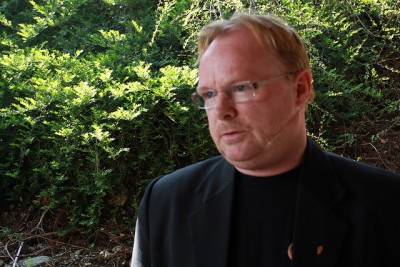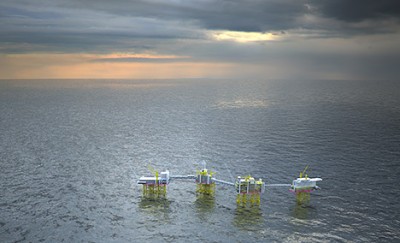The Progress Party accused the coalition government’s support parties, the Christian Democrats and Liberals, of breaching their agreements with the government by supporting electrification of the Utsira High oil field. The opposition parties united last week to call for full electrification of the project’s four new fields in a bid to cut emissions, but researchers warned the measure could actually have the opposite effect.

The Conservatives (Høyre) and Progress Party (Fremskrittspartiet, FrP) formed government last year after securing cooperation agreements with the Christian Democrats (Kristelig Folkeparti, KrF) and the Liberals (Venstre). On Thursday, outspoken Progress Party deputy Per Sandberg slammed the support parties on Norwegian Broadcasting (NRK) radio, saying they’d broken the cooperation agreement between the four parties by supporting the Utsira electrification proposal.
“Occasionally you get the impression that Venstre and KrF operate as if they sat in government alone,” Sandberg said. “It came like a bomb on us all. It came without KrF or the Liberals having consulted with us whatsoever.”
The agreement between the parties states that “the cooperation parties commit to consulting each other before they participate in other majorities that will have significant budgetary consequences or impact matters which are covered by this agreement.”
“Based on my interpretation I am in no doubt that at this point the agreement is broken,” said Sandberg. The agreement also provides the groundwork for the two support parties to fully join the government coalition at a later point in time, but Sandberg said he is no longer sure if that should happen. “That was my intention last autumn, but today I must be a little in doubt. I see that they sow discord instead of finding ways to collaborate.”
The Utsira project is not the first time the parties have clashed. The Christian Democrats and Liberals disagreed with the coalition’s measures to tighten asylum and immigration laws, and voiced concerns about some of the more vocal and conservative “loose canons” within the Progress Party.
Sandberg did not go so far as saying Prime Minister Erna Solberg should deny the support parties the chance to join the coalition, but said he already spends a lot of time putting out the fires caused by their statements. He said if the parties continued to behave the same way within government, it would cause friction.
“I must tell what is really happening,” Sandberg said. “We use a lot of energy and resources to refute matters that KrF and Venstre claim to have ownership over and gain support for. It causes friction. We’ve only been going for six months. We lose confidence in these parties when we don’t know how they’ll go forward.”
Electrification may emit more CO2
The parties called for the whole Utsira High area to be powered by electricity from shore, because they argued Norway’s clean hydro electricity would create far lower emissions that the gas turbines that would otherwise power the rigs. However, an environmental economics professor at the University of Oslo, Michael Hoel, said the measure could have the opposite effect.

Norway is focused on its own goal of cutting two thirds of emissions, and would simply shift the emissions problem from its own backyard into the European sphere, argued Hoel. “Clearly the electrification of the platforms in Utsira High will reduce the emissions in Norway, but it is by no means sure that it will reduce the global CO2 emissions,” he told newspaper Dagens Næringsliv (DN). “At worst, this will increase global CO2 emissions.”
He said when gas is burned on the platforms to produce power, the oil companies must buy CO2 quotas. If this gas is exported instead, it can be burned by customers who are outside the European emissions trading system. For instance, households don’t need to buy quotas for the gas they burn at home.
Hoel argued national emissions targets are actually in conflict with the logic behind the European quota system. He said Norway would be better placed to focus on emissions from the transport sector, which aren’t covered by the emissions trading scheme.
Experts divided
Asbjørn Torvanger from the climate and environmental research organization CICERO largely supported Hoel’s position, saying electrification is a climate measure with uncertain effects, even if you disregard the significance of the emissions trading scheme. “I think this here is often oversimplified,” he told DN. “You have an overly Norwegian perspective. You see that this is a measure which can help with Norwegian CO2 emissions. But if you look at the European perspective, the climate effect is a good deal less.”
The unions which commonly disagree with oil company managers were on their side when it came to the electrification issue. They feared it would make developments on the Norwegian continental shelf more expensive and less attractive, affecting investment and employment.
However, consultancy firm Point Carbon believed Hoel’s anaylsis was flawed. Head of carbon analysis Stig Schjølset said until 2020, there will be a surplus of carbon quotas in Europe. “The quotas are very cheap,” he said. “To put it simply, everyone emits as much as they want because the EU has already achieved its reduction in emissions.”
“That means that Norwegian cuts do not drive increased emissions in other places,” Schjølset concluded. “So if we reduce emissions by electrifying the whole Utsira High, this will also drive the sum of Norway and the EU’s emissions lower than it otherwise would be.”
newsinenglish.no/Emily Woodgate

